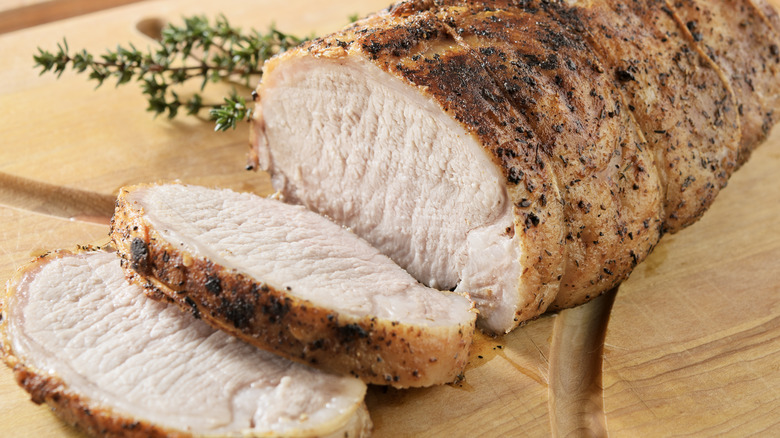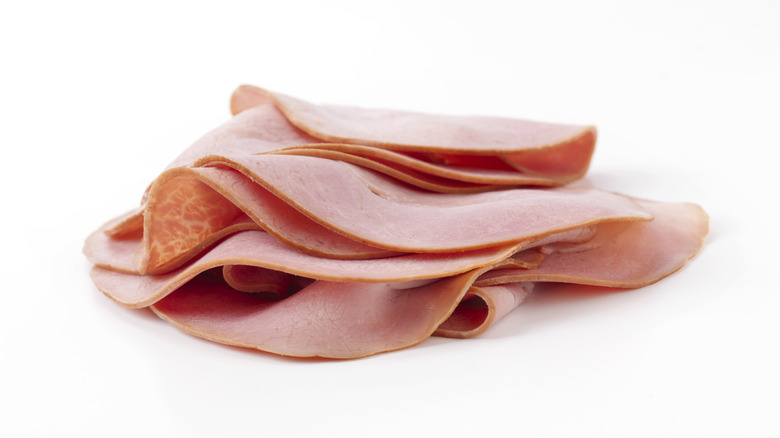Is Ham Red Meat, White Meat, Or A Secret Third Thing?
Ham: with its characteristic pink color, it occupies a middle zone between white meat and red meat, at least in purely visual terms. So, which is it?
The answer is ambiguous, but it's probably fair to say ham is closer to being red meat rather than white. Here's why: To simplify things as much as possible, ham is just pork from a pig's thigh that's been cured (and even when it's cured, it still falls under the pork umbrella — a little like how you'd still consider beef jerky to be a type of beef). So officially speaking, pork is classed as red meat. The U.S. Department of Agriculture classifies pork as red meat because the muscle (that is, the meat) contains a higher volume of myoglobin, a protein that adds red coloring to the flesh of animals like cows and sheep, and which is used to harness oxygen for energy production. White meat like chicken does have some myoglobin (especially in parts of the animals that get more of a workout, like the legs), but it overall has less — hence why chicken is white, and pork is red.
But isn't pork the other white meat?
Still, this technical classification hasn't stopped pork from sometimes being treated like white meat, particularly in the culinary world. A host of '80s and '90s commercials declared pork (and by extension, ham) to be "The other white meat." Unfortunately, you may have been tricked by the power of advertising. As Salon explains, the National Pork Producers Council spent millions of dollars on that ad campaign because chicken was becoming more popular among Americans, thanks to its lean, low-fat image. The pork producers wanted to hitch their wagon to chicken's popularity, so they set about rebranding pork as white meat, implying that it would be just as healthy as chicken. For the record, it worked, and pork sales soared, but it didn't change the official classification of pork (and ham) as red meat.
That said, it's not that this ad was a total lie: pork does have a distinctly white color when it's cooked, so some parts of the culinary world have treated it as white meat rather than red. But this doesn't really apply to ham; Ham is always a pink color because of the interactions between myoglobin in the meat, and the salt used in the curing process. So this pink color means there's no real justification to call ham "white meat" the way pork might be based on its lighter color.
Not white, not red, but processed
Both officially speaking and in terms of its color, ham is probably best described as red meat. But since it's cured and processed, it still might exist in a bit of a special category separate from regular pork. Here's why: The distinction between red and white meat tends to apply more to meats that are cooked — some sources treat processed meats as a separate category since they're not cooked in the same way. That is, instead of being cooked with heat (on a stove or in the oven), they're cured, smoked, or treated in some other way — and ham firmly fits this category since it's a cured meat.
Since processed meat is generally quite a bit higher in salt and fat, it's sometimes treated as a separate category from unprocessed meats (such as your regular pork or chicken, whether it's grilled, roasted, or stewed), particularly when it comes to dietary advice. In this sense, ham might exist in a bit of a special, third category: processed meat. At the end of the day, though, red, white, and processed meats are all just definitions that vary depending on who's using them.
So, while the best category for ham is still probably "red meat," there's no perfectly clear and unambiguous answer — and as long as you know what you're getting when you buy ham, that's fine, too.


